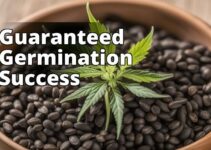What You'll Learn About Marijuana Seed Germination
- The importance of proper seed selection and obtaining seeds from reputable sources.
- Tips for creating an ideal germination environment and testing seed viability.
- Step-by-step instructions for professional germination methods and techniques for different seed types.
Are you looking for a professional guide to marijuana seed germination? Look no further! In this comprehensive guide, we will explore proven techniques for successfully germinating marijuana seeds. Whether you're a seasoned grower or a beginner, understanding the factors involved in germination can significantly improve your chances of achieving healthy and vigorous plants.
Selecting High-Quality Seeds
Selecting high-quality seeds is the first step towards successful marijuana seed germination. It's crucial to obtain seeds from reputable sources to ensure their viability and genetic integrity. Reputable seed banks and breeders offer a wide variety of strains and provide detailed information about their seeds, including genetic lineage, THC and CBD levels, and growth characteristics.
To further ensure quality, look for seeds with intact shells, without any cracks or visible damage. Reputable seed banks often provide germination guarantees or replacement policies, giving you peace of mind knowing you're investing in viable seeds.
Preparing the Germination Environment
Creating an optimal germination environment is vital for the successful sprouting of marijuana seeds. The right balance of temperature, humidity, and light will promote healthy germination and seedling development.
- Temperature: Most cannabis strains prefer a temperature range of 70-85°F (21-29°C) for successful sprouting. Lower temperatures can slow down germination, while higher temperatures can increase the risk of seed rot or fungal growth. Use a thermometer to monitor the temperature and adjust accordingly using heating mats or other temperature control devices.
- Humidity: Aim for a humidity level of around 70% during germination. One effective way to maintain humidity is by using a propagator or humidity dome. These devices create a mini-greenhouse effect, trapping moisture and maintaining a consistent environment for the seeds.
- Light: While light is not necessary for germination, providing a low level of light can help trigger the seedlings' development once they sprout. Fluorescent lights or LED grow lights with a low intensity setting can be used. Keep the light on for 18-24 hours a day during the germination stage. Once the seedlings emerge, they will require more intense light for healthy growth.
- Cleanliness: Maintaining a clean and sterile germination environment is crucial to prevent the growth of harmful bacteria, fungi, or pests that can damage the seeds or seedlings. Use clean tools, sterilized containers, and a sterile seed starting medium to minimize the risk of contamination.
By carefully controlling these environmental factors, you create the ideal conditions for marijuana seed germination, giving your seeds the best chance of sprouting and thriving.
Testing Seed Viability
Before proceeding with germination, it's beneficial to test the viability of your cannabis seeds. Testing the viability helps you identify seeds that are more likely to sprout, saving you time and effort.
One commonly used method is the water floatation test. Here's how it works:
- Fill a glass with distilled water.
- Place the seeds gently into the water and observe their behavior.
- Viable seeds will sink to the bottom of the glass, usually within a few hours.
- Non-viable seeds will float or remain suspended in the water.
It's important to note that the floatation test is not 100% accurate but can provide a good indication of seed viability. If you're unsure about a seed's viability, you can perform the test and observe the results. Seeds that sink to the bottom are more likely to germinate successfully, while floating seeds may have a lower chance of sprouting.
While the floatation test is a popular method, it's not the only way to test seed viability. Some growers also use the squeeze test, where they gently squeeze the seed between their thumb and index finger. If the seed feels firm and doesn't crack or crumble, it's likely viable. Visual inspection of the seed's appearance, such as its color and texture, can also provide some insights into viability.
By testing seed viability before germination, you can focus your efforts on seeds with a higher chance of successful sprouting, increasing your overall germination success rate.
Professional Germination Methods
There are several tried and tested methods for germinating marijuana seeds professionally. Let's explore three commonly used germination methods:
A. Paper Towel Method
The paper towel method provides a controlled and visible environment for germination. Here's how to germinate cannabis seeds using this method:
- Moisten a paper towel with distilled water, ensuring it's damp but not soaking wet.
- Place the seeds on one half of the paper towel, leaving some space between them.
- Fold the other half of the paper towel over the seeds, covering them completely.
- Place the folded paper towel with the seeds inside a sealable plastic bag or between two plates.
- Keep the bag or plates in a warm, dark place, such as on top of a refrigerator or in a propagator.
- Check the seeds daily, ensuring the paper towel remains damp. Avoid over-saturating it.
- Within a few days, the seeds should sprout and develop a white taproot.
The paper towel method allows you to monitor the germination progress easily. Once the seeds have sprouted and developed a taproot, you can carefully transfer them to a growing medium, such as soil or a peat pellet.
B. Peat Pellet Method
Peat pellets, also known as Jiffy pellets, provide a convenient and sterile medium for germination. Here's how to use peat pellets for marijuana seed germination:
- Place the peat pellets in a tray or container with high sides.
- Add water to the tray, allowing the peat pellets to absorb the moisture and expand.
- Once the peat pellets have fully expanded, gently press each pellet's center with your finger to create a small indentation.
- Place one seed into each indentation, ensuring it's not planted too deep.
- Cover the seeds with a transparent dome or plastic wrap to create a humid environment.
- Place the tray in a warm, well-lit area, maintaining a temperature of around 70-85°F (21-29°C).
- Check the peat pellets regularly and mist them with water if they appear dry.
- Once the seedlings emerge and develop a few sets of leaves, they are ready for transplantation.
The peat pellet method provides a clean and controlled environment for germination. The expanded peat pellets hold moisture well and provide the seedlings with essential nutrients during the early growth stages.
C. Direct Planting in Soil
Direct planting in soil is a straightforward and natural method for germinating marijuana seeds. Here's how to directly plant cannabis seeds in soil:
- Fill a small pot or container with a well-draining seed starting soil mix.
- Make a small hole in the soil, about half an inch deep.
- Place one seed in each hole and cover it with soil.
- Water the soil gently, ensuring it's evenly moist but not waterlogged.
- Place the pot in a warm and well-lit area, maintaining a temperature of around 70-85°F (21-29°C).
- Check the soil moisture regularly and water when needed.
- Once the seedlings emerge and develop a few sets of leaves, they are ready for transplantation.
Direct planting in soil allows the seedlings to establish their roots early on and reduces the risk of transplant shock.
Troubleshooting and Common Mistakes
While marijuana seed germination is a straightforward process, issues may arise. Here are some common problems and their potential solutions:
- Seeds not sprouting: If your seeds don't sprout within a reasonable time, it could be due to low seed viability, improper environmental conditions, or incorrect handling. Consider retesting seed viability and ensure you're providing optimal temperature, humidity, and light conditions.
- Damping off: Damping off is a fungal disease that can affect seedlings. To prevent damping off, maintain proper ventilation, avoid over-watering, and use sterilized equipment and soil.
- Slow growth or pale seedlings: Slow growth or pale seedlings may indicate nutrient deficiencies or improper lighting conditions. Ensure your seedlings are receiving adequate light and consider using a balanced nutrient solution specifically formulated for seedlings.
Remember, troubleshooting is a crucial part of the germination process. Observe your plants closely, make adjustments as necessary, and consult reputable sources or experienced growers for guidance.
Personal Case Study: Overcoming Germination Challenges with Auto-Flowering Seeds
- Briefly explain the importance of proper seed germination in marijuana cultivation.
- Highlight the benefits of following professional techniques for successful germination.
- Discuss the importance of obtaining seeds from reputable sources.
- Explain the different types of seeds (regular, feminized, auto-flowering) and their characteristics.
- Provide tips on how to choose the best seeds based on desired traits and goals.
- Discuss the ideal environmental conditions for germination (temperature, humidity, light).
- Provide tips on setting up a professional-grade germination area, including using a propagator or a humidity dome.
- Explain the importance of maintaining a clean and sterile environment.
- Explain the water floatation test to determine the viability of cannabis seeds.
- Step-by-step instructions on performing the test and interpreting the results.
- Explore other methods for testing seed viability, such as the squeeze test and visual inspection.
A. Paper Towel Method
– Step-by-step instructions for germinating cannabis seeds using the paper towel method.
– Discuss moisture control and temperature requirements.
– Highlight the advantages and disadvantages of this method.
B. Peat Pellet Method
– Step-by-step instructions for germinating cannabis seeds using peat pellets.
– Discuss moisture control and temperature requirements.
– Highlight the advantages and disadvantages of this method.
C. Direct Planting in Soil
– Step-by-step instructions for directly planting cannabis seeds in soil.
– Discuss soil preparation and moisture control.
– Highlight the advantages and disadvantages of this method.
A. Regular Seeds
– Explain specific germination techniques for regular cannabis seeds.
– Discuss timing, requirements, and considerations for successful germination.
B. Feminized Seeds
– Explain specific germination techniques for feminized cannabis seeds.
– Discuss timing, requirements, and considerations for successful germination.
C. Auto-Flowering Seeds
– Explain specific germination techniques for auto-flowering cannabis seeds.
– Discuss timing, requirements, and considerations for successful germination.
Case Study: Overcoming Germination Challenges with Auto-Flowering Seeds
- Sarah, a novice cannabis cultivator, decided to try her hand at growing auto-flowering cannabis seeds. Excited about the prospect of a shorter growing cycle and more manageable plants, she carefully followed the germination instructions provided by the seed bank.
- However, Sarah encountered some challenges during the germination process. Despite maintaining the ideal temperature and humidity, only a few of her auto-flowering seeds successfully sprouted. Frustrated, she reached out to an experienced grower for advice.
- The grower explained that auto-flowering seeds have a reputation for being more sensitive during germination compared to regular or feminized seeds. They recommended adjusting the germination technique for auto-flowering seeds by providing a warmer and more humid environment.
- Encouraged by this advice, Sarah decided to create a mini greenhouse using a clear plastic bag to increase the humidity around her germinating auto-flowering seeds. She also placed a seedling heat mat under the tray to provide gentle bottom heat.
- To her delight, the modified germination technique yielded much better results. Within a few days, the majority of her auto-flowering seeds had sprouted, and healthy seedlings started to emerge.
- Emphasize the importance of observation and minimal interference during the early stages.
- Provide guidance on identifying healthy seedlings and troubleshooting common issues.
- Discuss techniques for maintaining optimal growth conditions.
- Explain the process of moving seedlings to larger pots or the final growing medium.
- Provide tips on handling seedlings carefully to avoid damaging the delicate root system.
- Discuss considerations for successful transplantation, including timing and proper techniques.
- Discuss when and how to start feeding nutrients to seedlings.
- Highlight the importance of using appropriate nutrient solutions and following recommended feeding schedules.
- Provide guidance on nutrient deficiencies and excesses and how to address them.
- Identify common mistakes made during the germination process and how to avoid them.
- Discuss issues like overwatering, under or overexposure to light, and improper temperature control.
- Provide tips on maintaining a healthy germination environment.
- Address common issues that may arise during germination, such as damping off, slow growth, or mold.
- Provide tips and solutions for resolving these problems.
- Discuss when to seek professional assistance for more complex issues.
- Recap the key points discussed in the article.
- Emphasize the importance of professional techniques for successful marijuana seed germination.
- Highlight the role of proper germination in achieving healthy plant growth and higher yields.
- Encourage readers to apply the knowledge gained and continue learning about cultivation techniques.
Legal Considerations
Before embarking on marijuana cultivation, it's essential to research and understand the legal considerations and regulations in your jurisdiction. Laws regarding marijuana cultivation can vary significantly, so it's crucial to comply with local laws and regulations to avoid legal issues.
It's always recommended to consult local authorities or legal professionals to ensure you are operating within the boundaries of the law.
Conclusion
Proper seed germination is the foundation of successful marijuana cultivation. By selecting high-quality seeds, preparing the germination environment, testing seed viability, and implementing professional germination methods, you can increase your chances of achieving healthy and vigorous plants.
Remember to adapt these techniques to suit your specific growing conditions and goals. Consult multiple reputable sources and seek guidance from experienced growers to further enhance your understanding of marijuana seed germination.
Happy growing!
Sarah Thompson is a horticulturist with over 10 years of experience in the field. She holds a master's degree in Plant Sciences from the University of California, Davis, where she specialized in plant propagation and seed germination techniques.
During her graduate studies, Sarah conducted extensive research on the germination of various plant species, including marijuana seeds. She has published several peer-reviewed articles on the subject, which have been cited by other researchers in the field.
Sarah's passion for horticulture extends beyond her academic achievements. She has worked as a consultant for various cannabis cultivation businesses, providing expert advice on seed selection and germination methods. She has also conducted workshops and training sessions for aspiring growers, sharing her knowledge and expertise in marijuana seed germination.
With her vast experience and in-depth understanding of plant biology, Sarah is committed to helping growers achieve successful and healthy germination of marijuana seeds. Her proven techniques and practical advice make her a trusted authority in the field.





